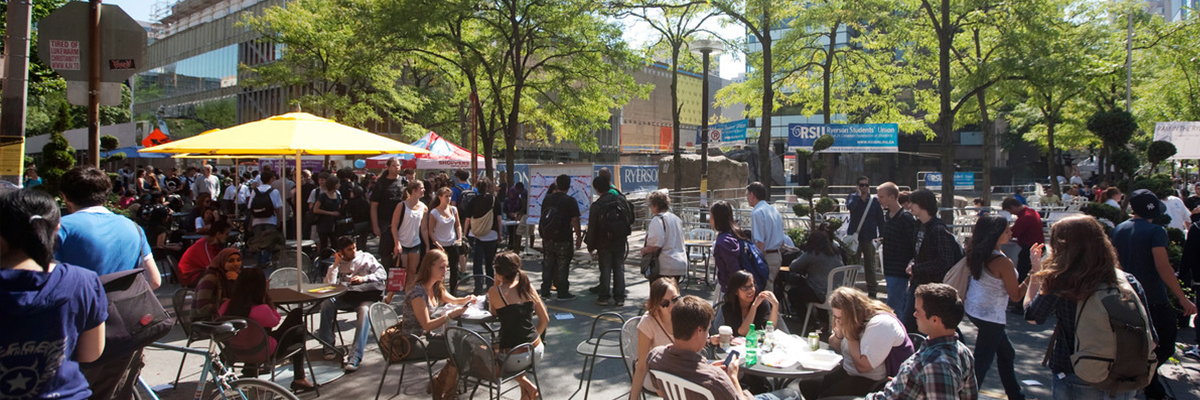Community Consultations

In order to solicit thoughts on classrooms from the widest possible set of Toronto Metropolitan University community members, the Centre for Excellence in Learning & Teaching and Facilities Management & Development (FMD) conducted a comprehensive consultation process in Fall/Winter 2018 that included a set of town halls targeted at faculty, instructors, students, and staff, as well as an online survey that was sent out to the entire Toronto Metropolitan University community.
Town Halls
There were five town halls, held for faculty, instructors, students, and staff between September 25 and October 3, 2018. In total, there were 69 attendees.
Through an interactive exercise, participants were given the opportunity to list all their ideas for how classrooms could be designed to address each value for learning and teaching spaces. These ideas were then reviewed by the group, and each participant was asked to vote on their top three ideas for each value. All responses were recorded and votes were tallied.
Online Survey
The online survey was open from September 11 to October 15, 2018. The option to fill out the survey in paper form was provided at the Campus Services Fair on September 27. In total, there were 371 responses to the survey.
The online survey asked participants to identify their role on campus (undergraduate student, graduate student, faculty/instructor, or staff), their faculty, and presented them with a set of open-ended questions:
What is the best learning experience you've had in the classroom?
- Please share a difficult learning experience you've had in the classroom.
- What are some of the biggest issues you see with the current classrooms?
- What is your vision of the ideal classroom?
- Do you have any additional comments that you'd like to share with us?
Participants
Responses were divided pretty evenly by faculty, with the most responses from the Faculty of Arts (19.2%) and the Ted Rogers School of Management (19.2%) and the fewest responses from the Chang School (8.6%).
- 59.6% of respondents identified as undergraduate students
- 24.4% of respondents identified as faculty or instructors
- 4.9% of respondents identified as graduate students
- 7.9% of respondents identified as staff
- 2.4% of respondents identified as Chang School students
- 0.8% of respondents identified as alumni
The majority of responses from students, faculty, instructors, and staff could be sorted into four specific themes: furniture, layout, comfort, technology, and flexibility.
Best Learning Experience
- Furniture: Well-maintained, clean, comfortable. Spacious desks, appropriate amount of furniture for room size.
- Layout: Appropriate for discipline and teaching format. Proper sightlines, good acoustics. Sufficient space.
- Comfort: Clean, well-maintained, brightly lit spaces with comfortable furniture. Consistent temperatures, good air circulation.
- Technology: Up-to-date, well-maintained, correctly configured (faculty). Easily accessible and sufficient power outlets (students).
- Flexibility in room configuration and lighting
Difficult Learning Experience
- Furniture: Broken, mismatched, missing, noisy, inaccessible.
- Layout: Inappropriate for format of class or teaching style. Inappropriate for the number of students or their needs.
- Comfort: Poor temperature and air circulation. Poor lighting and acoustics. Insufficient desk size, uncomfortable or unclean furniture.
- Technology: Outdated or poorly maintained (faculty). Lack of power outlets (students)
The Ideal Classroom
Professor delivers the content of the class clearly, loudly, without any line of sight issues. Students sit in comfortable seating, with enough room on the desk. There are no distractions, such as from noise from the classroom next door. There is good soundproofing, and presentation technology is accessed easily, and is maintained/serviced regularly.
Classroom with moveable tables and chairs, allowing for easy switches from lecture-style to group work (and ease of access for students with physical disabilities), lots of space, whiteboards on multiple walls (so both the instructor and students could use them), adjustable-height table for instructor podium. Lots of plugs, light switches both near the door and the podium, good soundproofing.
Relationship Between Classroom and Teaching
In response to the question “What is the best learning experience you've had in the classroom?” the majority of responses (57%) focused on pedagogy, where “best learning experiences” are a result of an engaging teaching style and great course design and delivery, regardless of the state of the classroom.
Students highlighted the importance of:
- Respect and care for students
- Engaging personalities and delivery methods
- Small class size allowing for group discussion and other interactions
- When professors demonstrate concepts by example (hands-on, real-life, simulations, demonstrations)
All comments at the town hall were coded and the top seven themes were identified per value for teaching and learning spaces. Participants felt that the following areas were the most important to consider when renovating or constructing new classrooms on campus.
Campus Environment
- Maintenance
- Lighting
- Furniture
- Safety
- HVAC
- Accessibility
- Power
Active Engagement
- Layout
- Furniture
- Accessibility
- Room Capacity
- Sightlines
- Power
- Technology
Inclusive Communities
- Accessibility
- Acoustics
- Furniture
- Technology
- Writing Surfaces
- Safety
- Indigenous Teaching
Exceptional Experiences
- Flexibility
- Technology
- Atmosphere
- Layout
- Upgrades
- Scheduling
- Comfort
To be genuine, accessibility must be a priority even when not convenient. Perhaps this is not the standard in classroom design, but it could be, and would show a genuine prioritization of the health and well-being of all students.